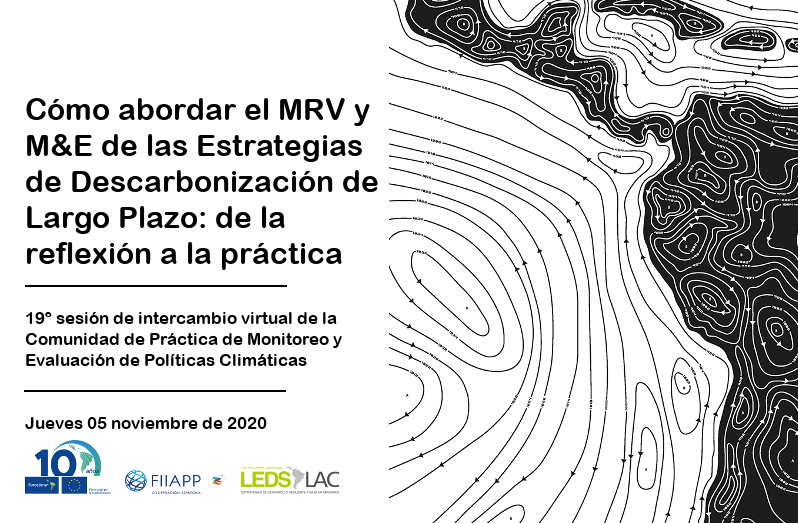19th virtual exchange session of the Community of Practice for Climate Policy Monitoring and Evaluation
-
On Thursday, November 5, the 19the virtual exchange° session of the Community of Practice for monitoring and evaluation of climate policies (CoP M&E) took place, supported by the International Foundation for Administration and Public Policy (FIIAPP) under the framework of the EUROCLIMA+ programme with the support of the LEDS LAC Platform. On this occasion, the session was part of the joint regional event organised by the LEDS LAC Platform, the EUROCLIMA+ programme, UNDP and the IDB, in line with the thematic axis on long-term strategies towards net zero emissions and green recovery.
The session, entitled "How to address MRV and M&E for Long-Term Decarbonisation Strategies: from Reflection to Practice" focused on opening a dialogue on the considerations to be taken in MRV/M&E systems in relation to a long-term decarbonisation strategy. After an introduction of the international context within which LTSs were framed by Andrés Pirazzoli, coordinator of the CoP M&E, the perspectives of Colombia and Chile were presented. On behalf of Colombia, comments were provided by Javier Mendoza, Coordinator of the 2050 Strategy and Eliana Hernandez, professional from the Adaptation Group of the Directorate of Climate Change and Risk Management of the Ministry of Environment and Sustainable Development (MADS), while on behalf of Chile, Jenny Mager from the Climate Change Office of the Ministry of Environment participated. After the conversation, group work was carried out with the members of the CoP to answer questions: What considerations should the design of an MRV/M&E system take from a LEDS/LTS? How does it link with NDC metrics? How do we make it consistent with other climate policy instruments such as NDCs, Adaptation Communications, INGEI, BUR, or others? What are the challenges you see when designing MRV/M&E for LTSs? What remains to be defined? What immediate needs are identified?
CONCLUSIONS
- This is a new issue: After some years of focusing efforts on designing nationally determined contributions (NDCs), countries are now focusing on designing long-term strategies, in response to the Paris Agreement's request that these be presented this year with recognition of their value in providing guidance towards ambitious climate goals. As a relatively new topic, discussions on M&E/MRV systems for LTS are just beginning.
- In Colombia:
- Under the leadership of MADS and in coordination with the National Directorate of Planning (NDP) and other organisations such as the Institute of Hydrology, Meteorology and Environmental Studies (IDEAM), work is being done to consolidate systems that allow for the integration of monitoring processes into a single system (e.g. Vulnerability and Risk Integration System; Climate Action Tool).
- Criteria are being defined to ensure that M&E is considered from the planning stage of projects and programmes to monitor the progress of implementation and the subsequent evaluation of the impacts of adaptation measures.
- The 2050 Strategy should be the guiding light and its M&E/MRV should be articulated with existing systems already in place incorporating appropriate indicators and raising awareness of long-term reporting.
- In Chile:
- The draft Climate Change Law sets the long-term goal of becoming a carbon neutral, resilient country by 2050. The long-term strategy is the instrument that articulates the policies for creating synergies with the other instruments.
- The strategy gives the long-term vision, has no detailed objectives, no specific targets, and no concrete measures. Each sector has mitigation and adaptation plans. These plans do have time bound objectives with timelines and indicators for monitoring.
- For its part, the NDC is intended to be an intermediate milestone in the strategy. The goals are linked and, in that regard, the NDC also serves to measure progress.
- To date, the LTS is in the preparation process, following a participatory process in several stages with expert workshops by sector components.
- General considerations:
- Long-term strategies are guiding instruments that establish a vision of where the country wants to go, without setting specific objectives or concrete measures. In that sense, there is no specific MRV/M&E for an LTS, rather there are systems associated with the monitoring of NDCs and climate policies. Also, international reporting schemes (National Communications and Biannual Update Reports) are important monitoring elements that serve as a basis.
- The cross-cutting nature of the LTSs requires efforts of inter-institutional articulation and coordination to make systems compatible between institutions and to ensure that the information collected is good and useful.
- Implementing instruments in a standardised way and using formats that actors are already familiar with (e.g. MRV climate financing should report the way financial institutions report).
- The LTSs are instruments that must be "alive". They must be able to be periodically reviewed and adapted to respond to institutional and political changes so that they do not become obsolete. Along this line, the indicators selected, and the monitoring and evaluation systems are a key factor.
- Challenges identified:
- "Short-termism" in the design of plans and programmes, and consequently in monitoring systems. The tendency to propose plans and programmes that temporarily cover administrative periods or particular projects limits the construction of indicators that allow monitoring long term goals or those aligned with the temporality of the changes in the natural systems.
- The definition of metrics and indicators, particularly in adaptation. Deciding on the right choice of what to measure (what is possible, feasible and necessary)
- Integration of the local into the national.
LINKS AND MATERIAL OF INTEREST

